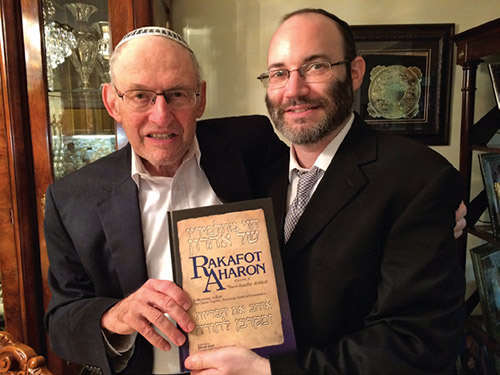

In advance of Yeshiva University’s SOY Seforim Sale, I’d like to offer a bit of a confession, an apology and an appreciation of a great scholar. Rav Aharon Rakeffet has developed a bit of a cult following, with his unique combination of historical narrative, deep Torah content and timely opinionating. His shiurim—all available online—are something of a Torah podcast with a deep impact across segments of Orthodoxy. Aside from his obvious Modern Orthodox audience, I know yeshivish rabbis who are experts in Rav Rakeffet’s lectures—his Torah, his history and his sharp, informed opinions on topics of the day.
Rav Rakeffet’s series of shiurim span years as he covers topics through broad periods of history, teaching halacha within a historical context without historicizing it. In other words, and this is important, he explains how Halacha was viewed and treated in different ages without claiming that Halacha was influenced by historical circumstance. In doing this, he takes a fully Orthodox approach while incorporating a historical perspective. This leads to fascinating and fruitful study, but takes time. He covers topics so thoroughly that you have to listen over many years to understand the topics from beginning to end. Thanks to the internet, Rav Rakeffet has many students who are able to study with him over the years. Personally, I was a listener before I ever met him, having joined the constantly expanding cyber-classroom of students who learn together with Rav Rakeffet about history, Halacha and the development of the contemporary Orthodox community.
When I finally got to meet him, it was in the context of editing his memoirs, “From Washington Avenue to Washington Street.” I was privileged to edit the manuscript in which Rav Rakeffet describes his progress from a boy growing up in the Bronx, to a close student of Rav Soloveitchik, to a Torah educator in Israel, to an Israeli agent teaching Torah in the Soviet Union. The book was published in 2011 by OU Press. I will explain my problem shortly, but first let me tell you about his latest book.
In 1997, Rav Rakeffet combined many of his published articles on Torah and Jewish history into two volumes of Rakafot Aharon. The books were published to raise funds for Shvut Ami, an organization that helps Russian Jews integrate into Israeli society and learn about Judaism. The books showcase Rav Rakeffet’s unique skills, his historical research into Torah scholars and his exposition of difficult Torah topics. In 2016, Shvut Ami published volume 3 of Rakafot Aharon, which attempts to convert his shiurim into a book (my wife and I were among the many sponsors of the publication). One of his internet students, Rabbi Dr. Yakov Weinstein, compiled and edited shiurim on extremely difficult halachic topics into lengthy, flowing essays that are accessible to any intelligent reader regardless of educational background. Rakafot Aharon Volume 3 covers the historical and halachic issues related to agunot, mamzerut and artificial insemination. You can see just from the topics a defining character trait: Rav Rakeffet does not avoid controversy; he carefully and intentionally runs straight into it.
Last year, Shvut Ami published the fourth volume of Rakafot Aharon (of which my wife and I were again among the many sponsors). The first half of the book is similar to Volume 3. It contains Rabbi Weinstein’s compilation of Rav Rakeffet’s series of lectures on Hafka’at Kiddushin, the controversial topic of annulment of marriages, concluding with an essay by Rav Rakeffet himself surveying the sources on the subject. An annulment solves so many halachic problems that sages throughout the generations have attempted to find practical ways to implement it, particularly in times of social turmoil such as following the expulsion from Spain. Sadly, despite all the rabbinic brainpower applied to this issue over the past millennium, no widespread solution has been found. After this historical-halachic section comes another of which I was the direct cause.
When I was editing Rav Rakeffet’s memoirs, I faced a problem: the manuscript was too long. I was charged with cutting down the length so that it would not intimidate readers, without diluting the story. I did so by removing large portions of Rav Rakeffet’s detailed travels in Russia during the 1980s. In approximately 100 pages, Rav Rakeffet records conversations, meetings, press releases and more about these travels. Unfortunately, I had to cut them from the book. “From Washington Avenue to Washington Street” has become a popular book, showing that a scholarly memoir can be compelling reading, offering a fascinating close-up view of the rabbinic world of the 20th century. However, much of the detail ended up on the cutting floor, including the names and accomplishments of great Jews who showed incredible dedication and character under Soviet oppression.
In Rakafot Aharon Volume 4, this is remedied. Section 2 of the book contains the full details of Rav Rakeffet’s Russian travels in the 1980s and color photos of these Jewish heroes. Finally, the full story is told. Section 3 includes Rav Rakeffet’s articles on contemporary Jewish history, including the life and Religious Zionism of Rav Joseph B. Soloveitchik; the story of Harry Fischel’s rise from poverty to pioneer Orthodox philanthropist; the under-appreciated genius of Zionist Torah giant Rav Reuven Katz of Petach Tikvah; the turbulent and controversial life of Rav Rakeffet’s Bnei Akiva madrich, Rabbi Meir Kahane; and more.
Rav Rakeffet is a unique Torah scholar, at once extremely accessible and yet his books are hard to acquire. All volumes of Rakafot Aharon are available exclusively from Shvut Ami, by making a donation to the organization. This year they will be available at YU’s SOY Seforim Sale, February 2-23.
By Rabbi Gil Student
�










